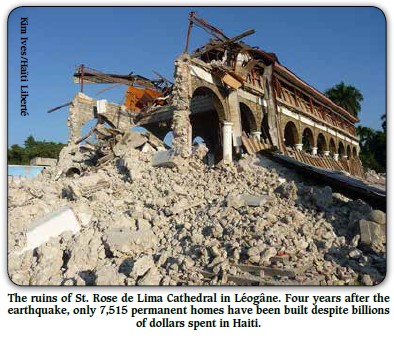|

As of Jan. 12, 2014:
Number of people killed in the earthquake
in 2010: over 217,300Number of people in Haiti killed by
the U.N.-caused cholera epidemic: 8,531Number of people
who died from cholera, on average, every day over the past six
months: 2Number of people in Haiti sickened by the
U.N.-caused cholera epidemic: over 696,865Budget for UN,
the U.S. CDC and the Haitian and Dominican governments’ plan to
eradicate cholera (launched over a year ago): $2.2 billion
Percent of cholera eradication plan budget
committed or pledged so far: 10
Percent of cholera eradication plan budget
pledged by the UN: 1
Annual budget for the UN’s mostly military
and police mission in Haiti (MINUSTAH): $577 million
Days since cholera was introduced in Haiti
without an apology from the UN: 1,179
“Number of international actors engaged in
cholera response efforts,” according to the U.N., in 2011:
120
“Number of international actors engaged in
cholera response efforts,” according to the U.N., in 2013: 43
U.N. Office of Coordination of Humanitarian
Affairs (OCHA) funding appeal for 2014: $169 million
Percent of last year’s OCHA appeal that was
actually funded: 42
Budget for Caracol industrial park: $300
million
Amount the Inter-American Development Bank
pledged this month for expansion of Caracol: $40.5 million
Number of households who lost farm and
grazing lands to make way for the Caracol park three years ago:
366
Number of people estimated to have received
jobs at Caracol out of a projected 65,000 jobs, as of July 2013:
2,000
Percent by which on average, workers at
Caracol are illegally underpaid, according to the Workers Rights
Consortium: 34
Minimum wage in Haiti, under law:
$7.00/day
Percent of garment factories in Haiti found
to be non-compliant with the minimum wage: 100
Cost of a basic basket of food in Haiti,
allowing for 1,979 kilocalories consumed per person per day
(August 2013 prices): $10
Percent of Haitian population living on
less than $2.00/day: over 80
Percent of Haitian population living on
less than $1.00/day: over 50
Percent of Haitian population estimated to
be “still suffering from the impact of both chronic and acute
needs”: 30
Prevalence of global acute malnutrition
amongst children under 5 years old in 2012: 5.1 percent
Prevalence of global acute malnutrition
amongst children under 5 years old in 2013: 6.5 percent
Number of beds at the new University
Hospital in Mirebalais, supported by Partners in Health: 300
Population served by the new,
state-of-the-art facility: 185,000
Number of Haitian doctors beginning medical
residencies at the new hospital: 14
For each $1 dollar invested in the
hospital, amount pushed into the broader Haitian economy:
$1.82
When fully operational, number of Haitians
employed by the hospital: 800
Total U.S. Government post-quake funding
earmarked for Haiti: $3.7 billion
Total U.S. Government disbursements of
funds for Haiti: $2.9 billion
Percent of USAID contracts that have gone
to Beltway-based firms: 67.1 [1]
Percent of USAID contracts that have gone
to Haitian companies: 1.3 [2]
Percent by which the U.S. government goal
of 15,000 new houses built has been reduced: over 80
Percent spent on shelter out of U.S.
government’s first $1.34 billion committed to Haiti: 9.2
Number of people displaced from their homes
by the earthquake: 1.5 million
Number of people remaining in internally
displaced person (IDP) camps: approximately 200,000
Number of people that the inter-agency
Shelter Cluster claims remain in IDP camps: 145,000
Percent of population displaced by the
earthquake who have left IDP camps, voluntarily or
involuntarily: 89
Number of IDP camps receiving official camp
management services, out of 306: 2
Number of houses assessed by Haiti’s
Ministry of Public Works, with the support of Miyamoto
International: 430,000
Number of houses found to damaged or
destroyed: 246,000
Number of masons trained with the support
of Miyamoto International: 6,000
Number of engineers trained with the
support of Miyamoto International: 600
Number of transitional shelters built by
aid agencies since the earthquake: 113,595
Number of new houses constructed since the
earthquake: 7,515
Number of houses that have been repaired:
26,547
Amount offered in rental assistance under
Martelly administration’s “16/6” plan: $500
Percent of participants in a recent IJDH
survey who still live in the home to which they were relocated
by the 16/6 program: 51
Percent of 16/6 participants reporting that
they are unable to pay rent: 61
Percent reporting that their most pressing
need is housing, in 2013: 56
Percent who reported that their most
pressing need was housing, in 2012: 9
Percent of survey participants reporting
that at least one family member went one or more days without
food: 68
Percent of survey participants reporting
that their children went without eating: 63
Percent of survey participants reporting
that they are eating worse than when living in the camps: 37
Percent of survey participants reporting
that they are eating worse than before the earthquake: 63
“In a 2011 study of five Internally
Displaced Persons camps in Haiti…percent [of] female
participants [who] had been directly involved in or witnessed
transactional sex, often performed in order to feed their
children”: 100
Percent of reported rape victims who are
adolescent girls: over 60
Percent of International Financial
Institution (IFI)-funded projects reviewed by Gender Action that
“discussed gender inequalities and gender roles in the project
rationale and background”: 58
Percent of IFI projects reviewed by Gender
Action that “ignored gender dimensions entirely”: 42
Percent of IFI projects reviewed by Gender
Action that “do not mention gender roles in consultations”:
83
Note:
1) Author’s calculations based on
information from USASpending.gov.
2) Ibid. |